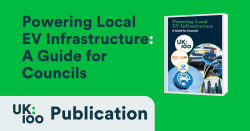What's this guide about?
Local authorities are central to delivering the UK's legally binding target to balance emissions by 2050. However, transport remains the largest source of greenhouse gas emissions, accounting for 29% of UK emissions. Electric vehicles offer a crucial solution, providing lower carbon emissions, reduced air and noise pollution, and cheaper running costs for drivers.
This guide, developed collaboratively by UK100, UK Power Networks DSO, and Cenex, provides senior leaders and officers with a practical roadmap for accelerating electric vehicle infrastructure deployment. It emphasises strategic planning, equitable access and financial sustainability whilst helping councils create thriving places powered by clean energy.
Why do you need this guide?
It will help you understand your pivotal role in EV infrastructure delivery
Local authorities manage public assets that will host EV infrastructure, influence planning policies, and shape street design. The guide explains how councils can lead by example through fleet electrification, develop inclusive charging networks, and ensure equitable access for all communities, including those without off-street parking.
It will outline how you can plan and implement an effective EV infrastructure strategy
The guide walks you through developing comprehensive EV strategies, from mapping community needs and auditing available sites to choosing the right commercial arrangements. It helps you understand different delivery models—own and operate, land lease, external operator, and concession—so you can select the approach that best suits your authority's capacity and objectives.
It will provide practical guidance on funding and partnerships
It covers funding opportunities including the Local EV Infrastructure (LEVI) Capital Fund, workplace and public sector schemes, and alternative financing arrangements beyond government grants. The guide also explains how to build robust business cases, minimise costs through strategic site selection, and leverage partnerships with Distribution Network Operators and other stakeholders.
It will help you navigate the connection process and technical requirements
Drawing on UK Power Networks' expertise, the guide demystifies the grid connection process, explains different chargepoint types and their costs, and introduces tools like ChargePoint Navigator to support data-driven site selection. It provides clear guidance on working with your local Distribution Network Operator or Distribution System Operator to ensure efficient installations.
It will guide you in building effective coalitions and ensuring accessibility
The guide addresses key challenges including managing political sensitivities, translating influencing work into local government structures, and building cross-party support. It emphasises the importance of accessible charging design, including PAS 1899 standards, to ensure EV infrastructure serves all residents, including disabled people who are expected to rely heavily on public charging.
Need any support?
- For additional support or to share feedback on this guide, reach out to UK100: membership@uk100.or
- If you are in London, South East or East of England, contact UK Power Networks DSO Local Net Zero team at LAEP@ukpowernetworks.co.uk to find out more about the free EV planning tool ChargePoint Navigator, or ask for further support on your EV planning.


